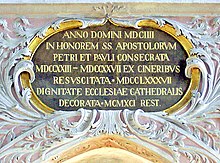

Anno Domini inscription at Klagenfurt Cathedral, Austria
The terms anno Domini (AD) and before Christ (BC) are used when designating years in the Gregorian and Julian calendars. The term anno Domini is Medieval Latin and means...
Mer info
Anno Domini inscription at Klagenfurt Cathedral, Austria
The terms anno Domini (AD) and before Christ (BC) are used when designating years in the Gregorian and Julian calendars. The term anno Domini is Medieval Latin and means "in the year of the Lord"[1] but is often presented using "our Lord" instead of "the Lord",[2][3] taken from the full original phrase "anno Domini nostri Jesu Christi", which translates to "in the year of our Lord Jesus Christ". The form "BC" is specific to English, and equivalent abbreviations are used in other languages: the Latin form, rarely used in English, is ante Christum natum (ACN) or ante Christum (AC).
This calendar era takes as its epoch the traditionally reckoned year of the conception or birth of Jesus. Years AD are counted forward since that epoch and years BC are counted backward from the epoch. There is no year zero in this scheme; thus the year AD 1 immediately follows the year 1 BC. This dating system was devised in 525 by Dionysius Exiguus but was not widely used until the 9th century.[4][5] (Modern scholars believe that the actual date of birth of Jesus was about 5 BC.[6][7][8][9])
Terminology that is viewed by some as being more neutral and inclusive of non-Christian people is to call this the Common Era (abbreviated as CE), with the preceding years referred to as Before the Common Era (BCE). Astronomical year numbering and ISO 8601 do not use words or abbreviations related to Christianity, but use the same numbers for AD years (but not for BC years since the astronomical year 0 is 1 BC).
Usage
[edit]Traditionally, English follows Latin usage by placing the "AD" abbreviation before the year number, though it is also found after the year.[10] In contrast, "BC" is always placed after the year number (for example: 70 BC but AD 70), which preserves syntactic order. The abbreviation "AD" is also widely used after the number of a century or millennium, as in "fourth century AD" or "second millennium AD" (although conservative usage formerly rejected such expressions).[11] Since "BC" is the English abbreviation for Before Christ, it is sometimes incorrectly concluded that AD means After Death (i.e., after the death of Jesus), which would mean that the approximately 33 years commonly associated with the life of Jesus would be included in neither the BC nor the AD time scales.[12]
Visa mindre
Biografi: LP

Anno Domini inscription at Klagenfurt Cathedral, Austria
The terms anno Domini (AD) and before Christ (BC) are used when designating years in the Gregorian and Julian calendars. The term anno Domini is Medieval Latin and means "in the year of the Lord"[1] but is often presented using "our Lord" ...
MerGör dig redo
Planera inför besöket:
Parkering
Mat & dryck
Övernattning
Biljetter till LP Event 01 PST for Announcement Date Checking
Välj mellan flera prisintervall och platser som passar upplevelsen du letar efter!
Köp biljetter i din mobil
- Använd mobilbiljetter för att skanna på arenan.
- Dela säkert dina biljetter med vännerna. Möt dem på arenan.
- Upptäck och köp biljetter till dina favoritevenemang.
- Publicera dina evenemangsminnen med minnesvärda biljetter, fotokollage och mycket mer.




